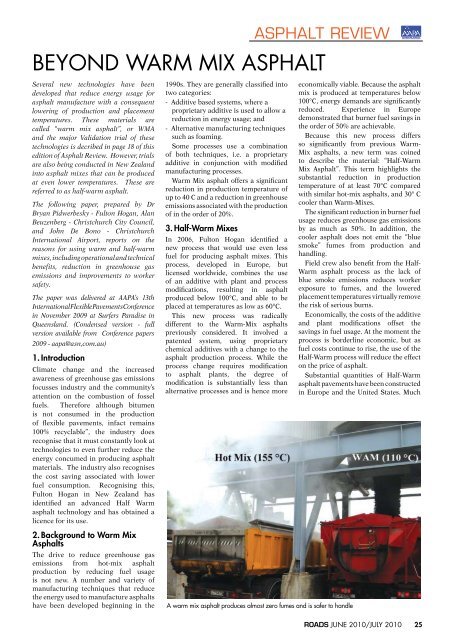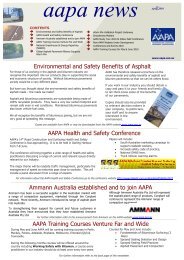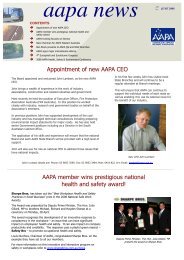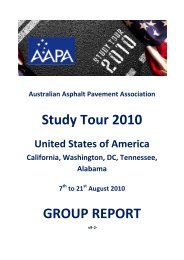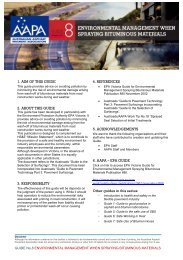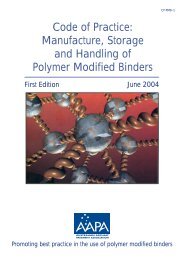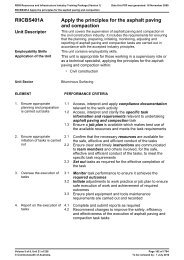Asphalt Review - Volume 29 Number 2 (June / July 2010)
Asphalt Review - Volume 29 Number 2 (June / July 2010)
Asphalt Review - Volume 29 Number 2 (June / July 2010)
Create successful ePaper yourself
Turn your PDF publications into a flip-book with our unique Google optimized e-Paper software.
Beyond Warm Mix <strong>Asphalt</strong><br />
Several new technologies have been<br />
developed that reduce energy usage for<br />
asphalt manufacture with a consequent<br />
lowering of production and placement<br />
temperatures. These materials are<br />
called “warm mix asphalt”, or WMA<br />
and the major Validation trial of these<br />
technologies is decribed in page 18 of this<br />
edition of <strong>Asphalt</strong> <strong>Review</strong>. However, trials<br />
are also being conducted in New Zealand<br />
into asphalt mixes that can be produced<br />
at even lower temperatures. These are<br />
referred to as half-warm asphalt.<br />
The following paper, prepared by Dr<br />
Bryan Pidwerbesky - Fulton Hogan, Alan<br />
Beuzenberg - Christchurch City Council,<br />
and John De Bono - Christchurch<br />
International Airport, reports on the<br />
reasons for using warm and half-warm<br />
mixes, including operational and technical<br />
benefits, reduction in greenhouse gas<br />
emissions and improvements to worker<br />
safety.<br />
The paper was delivered at AAPA’s 13th<br />
International Flexible Pavements Conference<br />
in November 2009 at Surfers Paradise in<br />
Queensland. (Condensed version - full<br />
version available from Conference papers<br />
2009 - aapa@asn,com.au)<br />
1. Introduction<br />
Climate change and the increased<br />
awareness of greenhouse gas emissions<br />
focusses industry and the community’s<br />
attention on the combustion of fossel<br />
fuels. Therefore although bitumen<br />
is not consumed in the production<br />
of flexible pavements, infact remains<br />
100% recyclable”, the industry does<br />
recognise that it must constantly look at<br />
technologies to even further reduce the<br />
energy concumed in producing asphalt<br />
materials. The industry also recognises<br />
the cost saving associated with lower<br />
fuel consumption. Recognising this,<br />
Fulton Hogan in New Zealand has<br />
identified an advanced Half Warm<br />
asphalt technology and has obtained a<br />
licence for its use.<br />
2. Background to Warm Mix<br />
<strong>Asphalt</strong>s<br />
The drive to reduce greenhouse gas<br />
emissions from hot-mix asphalt<br />
production by reducing fuel usage<br />
is not new. A number and variety of<br />
manufacturing techniques that reduce<br />
the energy used to manufacture asphalts<br />
have been developed beginning in the<br />
1990s. They are generally classified into<br />
two categories:<br />
- Additive based systems, where a<br />
proprietary additive is used to allow a<br />
reduction in energy usage; and<br />
- Alternative manufacturing techniques<br />
such as foaming.<br />
Some processes use a combination<br />
of both techniques, i.e. a proprietary<br />
additive in conjunction with modified<br />
manufacturing processes.<br />
Warm Mix asphalt offers a significant<br />
reduction in production temperature of<br />
up to 40 C and a reduction in greenhouse<br />
emissions associated with the production<br />
of in the order of 20%.<br />
3. Half-Warm Mixes<br />
In 2006, Fulton Hogan identified a<br />
new process that would use even less<br />
fuel for producing asphalt mixes. This<br />
process, developed in Europe, but<br />
licensed worldwide, combines the use<br />
of an additive with plant and process<br />
modifications, resulting in asphalt<br />
produced below 100°C, and able to be<br />
placed at temperatures as low as 60°C.<br />
This new process was radically<br />
different to the Warm-Mix asphalts<br />
previously considered. It involved a<br />
patented system, using proprietary<br />
chemical additives with a change to the<br />
asphalt production process. While the<br />
process change requires modification<br />
to asphalt plants, the degree of<br />
modification is substantially less than<br />
alternative processes and is hence more<br />
ASPHALT REVIEW<br />
A warm mix asphalt produces almost zero fumes and is safer to handle<br />
economically viable. Because the asphalt<br />
mix is produced at temperatures below<br />
100°C, energy demands are significantly<br />
reduced. Experience in Europe<br />
demonstrated that burner fuel savings in<br />
the order of 50% are achievable.<br />
Because this new process differs<br />
so significantly from previous Warm-<br />
Mix asphalts, a new term was coined<br />
to describe the material: “Half-Warm<br />
Mix <strong>Asphalt</strong>”. This term highlights the<br />
substantial reduction in production<br />
temperature of at least 70°C compared<br />
with similar hot-mix asphalts, and 30° C<br />
cooler than Warm-Mixes.<br />
The significant reduction in burner fuel<br />
usage reduces greenhouse gas emissions<br />
by as much as 50%. In addition, the<br />
cooler asphalt does not emit the “blue<br />
smoke” fumes from production and<br />
handling.<br />
Field crew also benefit from the Half-<br />
Warm asphalt process as the lack of<br />
blue smoke emissions reduces worker<br />
exposure to fumes, and the lowered<br />
placement temperatures virtually remove<br />
the risk of serious burns.<br />
Economically, the costs of the additive<br />
and plant modifications offset the<br />
savings in fuel usage. At the moment the<br />
process is borderline economic, but as<br />
fuel costs continue to rise, the use of the<br />
Half-Warm process will reduce the effect<br />
on the price of asphalt.<br />
Substantial quantities of Half-Warm<br />
asphalt pavements have been constructed<br />
in Europe and the United States. Much<br />
ROADS JUNE <strong>2010</strong>/JULY <strong>2010</strong> 25


